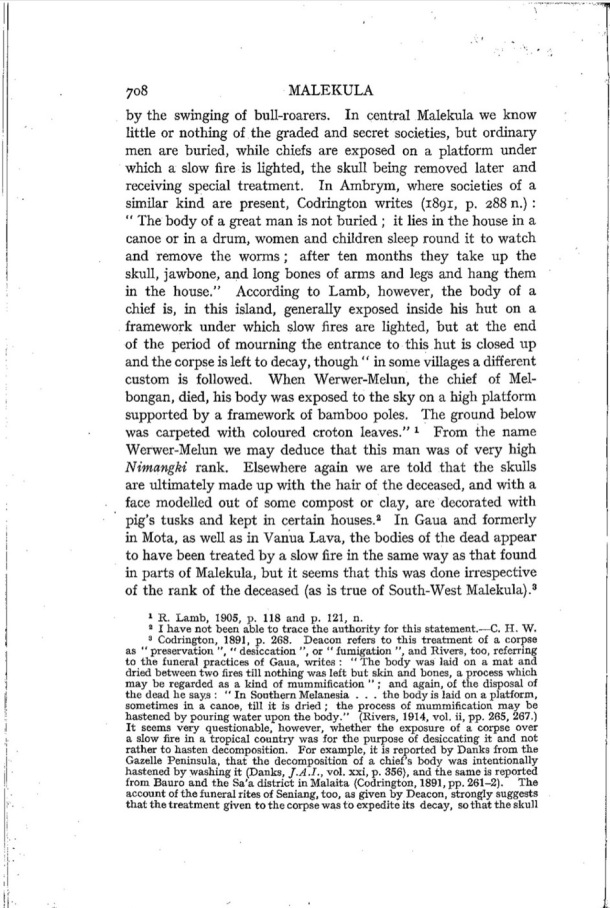|
|  [Note: this transcription was produced by an automatic OCR engine]
1
708 MALEKULA
by the swinging of bull-roarers. In central Malekula we know
little or nothing of the graded and secret societies, but ordinary
men are buried, while chiefs are exposed on a platform under
which a slow ï¬Åre is lighted, the skull being removed later and
reoeiving special treatment. In Ambrym, where societies of a
similar kind are present, Cudrington writes (18gr, p. 288 n.):
" The body of a great man is not buried ; it lies in the house in a
canoe or in a drum, women and children sleep round it to watch
and remove the worms ; after ten months they take up the
skull, jawbone, and long bones of arms and legs and hang them
in the house." According to Lamb, however, the body of a
chief is, in this island, generally exposed inside his hut on a
framework under which slow ï¬Åres are lighted, but at the end
of the period of mourning the entrance to this hut is closed up
and the corpse is left to decay, though " in some villages a different
custom is followed. When Werwer-Melun, the chief of Mel-
bongan, died, his body was exposed to the sky on a high platform
supported by a framework of bamboo poles. The ground below
was carpeted with coloured croton leaves." 1 From the name
Werwer-Melun we may deduce that this man was of very high
Nimangki rank. Elsewhere again we are told that the skulls
are ultimately made up with the hair of the deceased, and with a
face modelled out of some compost or clay, are decorated with
pig's tusks and kept in certain houses.‘ In Gaua and formerly
in Mota, as well as in Vanua Lava, the bodies of the dead appear
to have been treated by a slow ï¬Åre in the same way as that found
in parts of Malekula, but it seems that this was done irrespective
of the rank of the deceased (as is true of South-West Malekula).’
1 R. Lamb, 1905, p. us and p. 121, n.
I r have not been able to trace the uuchoriry for this statement.-—C. H. w.
= Codrington, issi, p. 26s. Deacon refers to this treatment of a. cbrpcc
rn " preservation -- dcuiccntion or " iumigetion and Rivera, too, referring
to the iuneral practices of Gaua, writes: “ The body was lrud on a mat and
dried between two ï¬Åres till nothing wnr left bur skin and bones, c Krona: which
rnuy be regarded as u kind cf rnummiï¬Åcation "; and again, n1 t u dixposal or
the (19841 lie says: " rrr Southern Melanesia . . . the body is irid on a. piuunrnr,
sometimes in a. canoe, till it is dried; the process of mumruiï¬Åntion may be
hastened by pouring water upon the body." (Rivers, 1914, vol. ii, ‘pp. 265, 261.)
It seems very questionable, however, whether the exposure of 4 corpse over
a slow ï¬Åre in r tropical country was for the purpose of desicchting it and not
lather to hasten decomposition. For example, it is reported by Dhnlrs from the
Gazelle Peninsula, that the decomposition 0! a chiels body was intentionally
hastened by washing it (Danks, J./1.1., vol. xxi, p. ass), and the Sim: is reported
ircrn Buurn and the Sa'a district in Malaita (Codrington,1891,p-p. 2s1-2). Thu
account of the funeral rites or Seniang, too, as given by Deacon, strongly suggests
an-it thetreatment given tothe corpse was to expeditoits decay, sothat the rirun
|